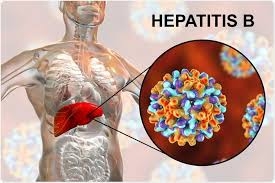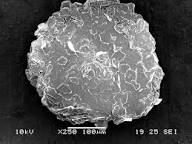Hepatitis B is a viral infection that attacks the liver and can cause both acute and chronic disease.
The virus is most commonly transmitted from mother to child during birth and delivery, as well as through contact with blood or other body fluids, including sex with an infected partner, injection-drug use that involves sharing needles, syringes, or drug-preparation equipment and needle sticks or exposures to sharp instruments.
WHO estimates that in 2015, 257 million people were living with chronic hepatitis B infection (defined as hepatitis B surface antigen positive).
In 2015, hepatitis B resulted in an estimated 887 000 deaths, mostly from cirrhosis and hepatocellular carcinoma (i.e. primary liver cancer).
As of 2016, 27 million people (10.5% of all people estimated to be living with hepatitis B) were aware of their infection, while 4.5 million (16.7%) of the people diagnosed were on treatment. According to latest WHO estimates, the proportion of children under five years of age chronically infected with HBV dropped to just under 1% in 2019 down from around 5% in the pre-vaccine era ranging from the 1980s to the early 2000s.
Hepatitis B can be prevented by vaccines that are safe, available and effective.
Hepatitis B is a potentially life-threatening liver infection caused by the hepatitis B virus (HBV). It is a major global health problem. It can cause chronic infection and puts people at high risk of death from cirrhosis and liver cancer.
A safe and effective vaccine that offers a 98-100% protection against hepatitis B is available. Preventing hepatitis B infection averts the development of complications including the development of chronic disease and liver cancer.
Geographical distribution
Hepatitis B prevalence is highest in the WHO Western Pacific Region and the WHO African Region, where 6.2% and 6.1% of the adult population is infected respectively. In the WHO Eastern Mediterranean Region, the WHO South-East Asia Region and the WHO European Region, an estimated 3.3%, 2.0% and 1.6% of the general population is infected, respectively. And in the WHO Region of the Americas, 0.7% of the population is infected.
TRANSMISSION
In highly endemic areas, hepatitis B is most commonly spread from mother to child at birth (perinatal transmission), or through horizontal transmission (exposure to infected blood), especially from an infected child to an uninfected child during the first 5 years of life. The development of chronic infection is very common in infants infected from their mothers or before the age of 5 years.
needlestick injury, tattooing, piercing
Hepatitis B is also spread by and exposure to infected blood and body fluids, such as saliva and, menstrual, vaginal, and seminal fluids. Sexual transmission of hepatitis B may occur, particularly in unvaccinated men who have sex with men and heterosexual persons with multiple sex partners or contact with sex workers.
Infection in adulthood leads to chronic hepatitis in less than 5% of cases, whereas infection in infancy and early childhood leads to chronic hepatitis in about 95% of cases. Transmission of the virus may also occur through the reuse of needles and syringes either in health-care settings or among persons who inject drugs. In addition, infection can occur during medical, surgical and dental procedures, through tattooing, or through the use of razors and similar objects that are contaminated with infected blood.
The hepatitis B virus can survive outside the body for at least 7 days. During this time, the virus can still cause infection if it enters the body of a person who is not protected by the vaccine. The incubation period of the hepatitis B virus is 75 days on average, but can vary from 30 to 180 days. The virus may be detected within 30 to 60 days after infection and can persist and develop into chronic hepatitis B.
SYMPTOMS
Most people do not experience any symptoms when newly infected. However, some people have acute illness with symptoms that last several weeks, including yellowing of the skin and eyes (jaundice), dark urine, extreme fatigue, nausea, vomiting and abdominal pain. A small subset of persons with acute hepatitis can develop acute liver failure, which can lead to death.
In some people, the hepatitis B virus can also cause a chronic liver infection that can later develop into cirrhosis (a scarring of the liver) or liver cancer.
Who is at risk of chronic disease?
The likelihood that infection becomes chronic depends on the age at which a person becomes infected. Children less than 6 years of age who become infected with the hepatitis B virus are the most likely to develop chronic infections.
IN INFANTS AND CHILDREN:
80–90% of infants infected during the first year of life develop chronic infections; and
30–50% of children infected before the age of 6 years develop chronic infections.
In adults:
less than 5% of otherwise healthy persons who are infected as adults will develop chronic infections; and
20–30% of adults who are chronically infected will develop cirrhosis and/or liver cancer.
HBV-HIV coinfection
About 1% of persons living with HBV infection (2.7 million people) are also infected with HIV. Conversely, the global prevalence of HBV infection in HIV-infected persons is 7.4%. Since 2015, WHO has recommended treatment for everyone diagnosed with HIV infection, regardless of the stage of disease. Tenofovir, which is included in the treatment combinations recommended as first-line therapy for HIV infection, is also active against HBV.
DIAGNOSIS
It is not possible, on clinical grounds, to differentiate hepatitis B from hepatitis caused by other viral agents, hence, laboratory confirmation of the diagnosis is essential. A number of blood tests are available to diagnose and monitor people with hepatitis B. They can be used to distinguish acute and chronic infections.
Laboratory diagnosis of hepatitis B infection focuses on the detection of the hepatitis B surface antigen HBsAg. WHO recommends that all blood donations be tested for hepatitis B to ensure blood safety and avoid accidental transmission to people who receive blood products.
Acute HBV infection is characterized by the presence of HBsAg and immunoglobulin M (IgM) antibody to the core antigen, HBcAg. During the initial phase of infection, patients are also seropositive for hepatitis B e antigen (HBeAg). HBeAg is usually a marker of high levels of replication of the virus. The presence of HBeAg indicates that the blood and body fluids of the infected individual are highly infectious.
Chronic infection is characterized by the persistence of HBsAg for at least 6 months (with or without concurrent HBeAg). Persistence of HBsAg is the principal marker of risk for developing chronic liver disease and liver cancer (hepatocellular carcinoma) later in life.
TREATMENT
There is no specific treatment for acute hepatitis B. Therefore, care is aimed at maintaining comfort and adequate nutritional balance, including replacement of fluids lost from vomiting and diarrhoea. Most important is the avoidance of unnecessary medications. Acetaminophen/Paracetamol and medication against vomiting should not be given.
Chronic hepatitis B infection can be treated with medicines, including oral antiviral agents. Treatment can slow the progression of cirrhosis, reduce incidence of liver cancer and improve long term survival. Only a proportion (estimates vary from 10% to 40% depending on setting and eligibility criteria) of people with chronic hepatitis B infection will require treatment.
WHO recommends the use of oral treatments - tenofovir or entecavir- as the most potent drugs to suppress hepatitis B virus. They rarely lead to drug resistance compared with other drugs, are simple to take (1 pill a day), and have few side effects, so require only limited monitoring.
Entecavir is off-patent. In 2017, all low- and middle-income countries could legally procure generic entecavir, but the costs and availability varied widely. Tenofovir is no longer protected by a patent anywhere in the world. The median price of WHO-prequalified generic tenofovir on the international market fell from US$ 208 per year to US$ 32 per year in 2016.
In most people, however, the treatment does not cure hepatitis B infection, but only suppresses the replication of the virus. Therefore, most people who start hepatitis B treatment must continue it for life.
There is still limited access to diagnosis and treatment of hepatitis B in many resource-constrained settings. In 2016, of the more than 250 million people living with HBV infection, 10.5% (27 million) were aware of their infection. Of those diagnosed, the global treatment coverage is 16.7% (4.5 million). Many people are diagnosed only when they already have advanced liver disease.
Among the long-term complications of HBV infections, cirrhosis and hepatocellular carcinoma cause a large disease burden. Liver cancer progresses rapidly, and since treatment options are limited, the outcome is generally poor. In low-income settings, most people with liver cancer die within months of diagnosis. In high-income countries, surgery and chemotherapy can prolong life for up to a few years. Liver transplantation is sometimes used in people with cirrhosis in high income countries, with varying success.
PREVENTION
The hepatitis B vaccine is the mainstay of hepatitis B prevention. WHO recommends that all infants receive the hepatitis B vaccine as soon as possible after birth, preferably within 24 hours – followed by two or three doses of hepatitis B vaccine at least four weeks apart to complete the series. Timely birth dose is an effective measure to reduce transmission from mother-to-child.
According to latest WHO estimates, the proportion of children under five years of age chronically infected with HBV dropped to just under 1% in 2019 down from around 5% in the pre-vaccine era ranging from the 1980s to the early 2000s.
This marks the achievement of one of the milestone targets to eliminate viral hepatitis in the Sustainable Development Goals ─ to reach under 1% prevalence of HBV infections in children under five years of age by 2020.
The scale-up of hepatitis B vaccine worldwide over the last two decades has been a great public health success story and contributed to the decrease in HBV infections among children
In 2019, coverage of 3 doses of the vaccine reached 85% worldwide compared to around 30% in 2000. However, coverage of the hepatitis B vaccine birth dose remains uneven. Global coverage of the HBV birth dose, for example, is 43%, while coverage in the WHO African Region is only 6%. .
The complete vaccine series induces protective antibody levels in more than 95% of infants, children and young adults. Protection lasts at least 20 years and is probably lifelong. Thus, WHO does not recommend booster vaccinations for persons who have completed the 3-dose vaccination schedule.
All children and adolescents younger than 18 years and not previously vaccinated should receive the vaccine if they live in countries where there is low or intermediate endemicity. In those settings it is possible that more people in high-risk groups may acquire the infection and they should also be vaccinated. This includes;
people who frequently require blood or blood products, dialysis patients and recipients of solid organ transplantations;
people in prisons;
people who inject drugs;
household and sexual contacts of people with chronic HBV infection;
people with multiple sexual partners;
healthcare workers and others who may be exposed to blood and blood products through their work; and
travellers who have not completed their HBV series, who should be offered the vaccine before leaving for endemic areas.
The vaccine has an excellent record of safety and effectiveness and the proportion of children under five years of age chronically infected with HBV dropped to just under 1% in 2019 down from around 5% in the pre-vaccine era ranging from the 1980s to the early 2000s.
In addition to infant vaccination, including a timely birth dose, WHO recommends the use of antiviral prophylaxis for the prevention of hepatitis B transmission from mother-to-child. Pregnant women with high levels of HBV DNA (viral load) and/or the presence of HBeAG have an elevated risk of transmitting the virus to their child, even among infants who receive the timely birth dose and the complete hepatitis B vaccine series. As such, pregnant women with high HBV DNA levels may be eligible for antiviral prophylaxis during pregnancy to prevent perinatal HBV infection and protect their infants from contracting the disease.
In addition to infant vaccination and prevention of mother-to-child-transmission, implementation of blood safety strategies, including quality-assured screening of all donated blood and blood components used for transfusion, can prevent transmission of HBV. Worldwide, in 2013, 97% of blood donations were screened and quality assured, but gaps persist. Safe injection practices, eliminating unnecessary and unsafe injections, can be effective strategies to protect against HBV transmission. Unsafe injections decreased from 39% in 2000 to 5% in 2010 worldwide. Furthermore, safer sex practices, including minimizing the number of partners and using barrier protective measures (condoms), also protect against transmission.
WHO response
In May 2016, the World Health Assembly adopted the first "Global health sector strategy on viral hepatitis, 2016-2020". The strategy highlights the critical role of universal health coverage and sets targets that align with those of the Sustainable Development Goals.
The strategy has a vision to eliminate viral hepatitis as a public health problem. This is encapsulated in the global targets to reduce new viral hepatitis infections by 90% and reduce deaths due to viral hepatitis by 65% by 2030. Actions to be taken by countries and the WHO Secretariat to reach these targets are outlined in the strategy.
To support countries in achieving the global hepatitis elimination targets under the Sustainable Development Agenda 2030, WHO is working to:
raise awareness, promote partnerships and mobilize resources;
formulate evidence-based policy and data for action;
increase health equities within the hepatitis response
prevent transmission; and
scale up screening, care and treatment services.
In March 2015, WHO launched its first "Guidelines for the prevention, care and treatment of persons living with chronic hepatitis B infection".
The recommendations include:
promote the use of simple, non-invasive diagnostic tests to assess the stage of liver disease and eligibility for treatment;
prioritize treatment for those with the most advanced liver disease and at greatest risk of mortality; and
recommend the preferred use of the nucleos(t)ide analogues with a high barrier to drug resistance (tenofovir and entecavir, and entecavir in children aged 2–11 years) for first- and second-line treatment.
These guidelines also recommend lifelong treatment for those with cirrhosis and those with high HBV DNA and evidence of liver inflammation, and regular monitoring for those on treatment, as well as those not yet on treatment for disease progression, indications for treatment and early detection of liver cancer.
In July 2020 WHO published additional guidance on “Prevention of mother-to-child transmission of hepatitis B virus: Guidelines on antiviral prophylaxis in pregnancyâ€.
In addition to the series of hepatitis B vaccinations (including a first dose within 24 hours of birth), WHO now recommends that pregnant women testing positive for HBV infection (HBsAg positive) with an HBV DNA equal to or greater 200,000 IU/ml receive tenofovir prophylaxis; the preventive therapy should be provided from the 28th week of pregnancy until at least birth.
Some settings have poor access to tests that quantify an individual’s HBV viral load and determine whether a pregnant woman would be eligible for preventative treatment or prophylaxis. This is especially the case in low income settings or rural areas where many antenatal care visits take place. In settings where antenatal HBV DNA testing is not available, WHO now recommends the use of HBeAg testing as an alternative to determine eligibility for tenofovir prophylaxis for the prevention of mother-to-child transmission of HBV.
The hepatitis B testing and treatment of eligible pregnant women can be integrated with the prevention of mother-to-child transmission of HIV and congenital syphilis with antenatal care service. This approach is often referred to as ‘Triple elimination’ – an initiative that promotes the elimination of mother-to-child transmission of three infections: HIV, syphilis and hepatitis B virus.
In addition, WHO recently published the “Progress report on HIV, viral hepatitis and sexually transmitted infections, 2019â€, outlining its progress towards elimination. The report sets out global statistics on viral hepatitis B and C, the rates of new infections, the prevalence of chronic infections and mortality caused by these 2 high-burden viruses, and coverage of key interventions, all current as at the end of 2016 and 2017.
Moreover, since 2011, together with national governments, partners and civil society, WHO has organized annual World Hepatitis Day campaigns (as 1 of its 9 flagship annual health campaigns) to increase awareness and understanding of viral hepatitis. The date of 28 July was chosen because it is the birthday of Nobel-prize winning scientist Dr Baruch Bloomberg, who discovered the hepatitis B virus and developed a diagnostic test and vaccine for it.
For World Hepatitis Day 2020, WHO is focusing on the theme “Hepatitis-Free Future†to highlight the importance of addressing the prevention of mother-to-child transmission of HBV, launch new guidance, and to call for increased domestic and international programming and funding to prevent hepatitis B mother-to-child transmission and expand access to hepatitis prevention, testing and treatment services, with a view to achieving the 2030 elimination targets.
WHO publication.



